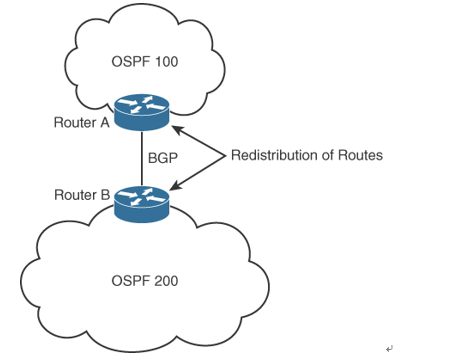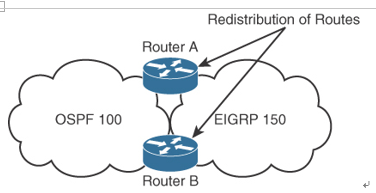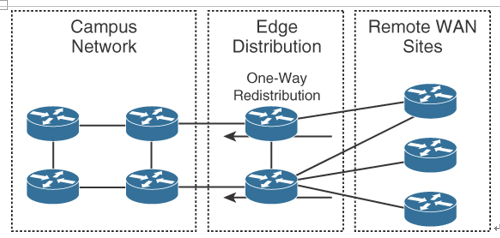Route Redistribution – OSPF, BGP, and Route Manipulation
Route redistribution is an exchange of routes between routing protocols (for example, between EIGRP and OSPF). You configure the redistribution of routing protocols on routers that reside at the service provider edge of the network or an autonomous system boundary within the internal network. These routers exchange routes with other autonomous systems. Redistribution is also done on routers that run more than one routing protocol. Here are some reasons to do redistribution:
- Migration from an older routing protocol to a new routing protocol
- Mixed-vendor environment in which Cisco routers might be using EIGRP and other vendor routers might be using OSPF
- Different administrative domain between company departments using different routing protocols
- Mergers and acquisitions in which the networks initially need to communicate, when two different EIGRP processes might exist
Routes can be learned from different sources. One source is a static route that is configured when not peering with the AS external router. Another source is a different routing protocol where you might be running EIGRP and the other network uses OSPF. Another common example is when peering with an ISP, the enterprise is commonly using OSPF, and the Internet routers peer with the ISP router using BGP.
Figure 4-21 shows an example of the exchange of routes between two autonomous systems. Routes from AS 100 are redistributed into BGP on Router A. Routes from AS 200 are redistributed into BGP on Router B. Then Routers A and B exchange BGP routes. Router A and Router B also implement filters to redistribute only the desired networks.

Figure 4-21 IDS and IPS Operational Differences
Say that a company acquires another company that is running another routing protocol. Figure 4-22 shows a network using both OSPF and EIGRP routing protocols. Routers A and B perform redistribution between OSPF and EIGRP. Both routers must filter routes from OSPF before redistributing them into EIGRP and must filter routes from EIGRP before redistributing them into OSPF. This setup prevents route feedback.

Figure 4-22 Redistribution Between IGPs
Route feedback occurs when a routing protocol learns routes from another routing protocol and then announces the routes to the other routing protocol. In Figure 4-21, OSPF should not advertise the routes it learned from EIGRP on Router A back to EIGRP on Router B. And EIGRP should not announce the routes it learned from OSPF on Router B back to OSPF on Router A.
You can use access lists, distribution lists, and route maps when redistributing routes. You can use these methods to specify (select) routes for redistribution, to set metrics, or to set other policies for the routes. These methods are used to prevent loops in the redistribution. They are also used to control routes’ redistribution direction. Redistribution can be accomplished by two methods:
- Two-way redistribution: In two-way redistribution, routing information is exchanged between the two routing protocols. No static routes are used in this exchange. Route filters are used to prevent routing loops. Routing loops can be caused by one route protocol redistributing routes that were learned from a second route protocol back to that second routing protocol.
- One-way redistribution: One-way redistribution allows redistribution from only one routing protocol to another. Normally, it is used in conjunction with a default or static route at the edge of a network. Figure 4-23 shows an example of one-way redistribution. The routing information from the WAN routes is redistributed into the campus, but campus routes are not redistributed out to the WAN. The WAN routers use a default route to get back to the campus.

Figure 4-23 One-Way Route Redistribution
Other locations for one-way redistribution are from building access networks, from BGP routes or static routes into the IGP, and from VPN static routes into the IGP.
